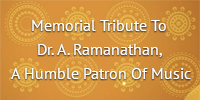Looking at the evolution of languages in India, we see that though Sanskrit was among the earliest languages used in the Indian sub-continent, Prākṛt gained popularity even during the times of the great playwrights such as Bhāsa and Kālidāsa which in due course gave rise to many regional languages. It is however interesting to note that Sanskrit continued to be the preferred language for many philosophers as well as vāggeyakāras to compose their works. Though Tyāgarāja svāmi chose Telugu as the primary language for his compositions, he seems to have not escaped the attraction of Sanskrit which is amply seen in his compositions.
Use of Sanskritised Telugu
Most of the compositions of Tyāgarāja svāmi are in Telugu. However, if we look at some of these in detail, we find that a significant portion of the lyrics in these would be Sanskrit with some colophons/ concluding/ starting lines in Telugu. This is what has been indicated here by the term ‘Sanskritised Telugu’. Below are some popular examples of these:
- In the Aṭhāṇā kṛti Elā nī dayarādu, except for the line ‘Elā nī dayarādu parāku jese elā samayamu gādu’ and the terms ‘Rā Rā’, everything is Sanskrit!
- In the kṛti Amma Dharmasamvardhini again in Aṭhāṇā, except for the pallavi and anupallavi, the three charanas are all in chaste Sanskrit.
Use of innovative epithets
The Sanskrit proficiency of Tyāgarāja svāmi is seen in the different innovative epithets he uses in his compositions. He uses the term ‘Sāmaja’ extensively for the elephant. However, we don’t find many references to the term ‘Sāmaja’ used for the elephant in Vedic or classical Sanskrit literature. Thus, in a way, this could be termed an innovation of Tyāgarāja svāmi. Literally ‘born of Sāma’, the term connects the elephant with the Sāmaveda. Referring to Kumbhakarṇa, he calls him ‘Ghaṭakarṇa’ replacing ‘Kumbha’ by its synonym ‘Ghaṭa’ in the Huseni kṛti Raghuvīra Raṇadhīra. In the same kṛti, he uses two ways to describe Indra – one as Balārāti i.e. arāti or enemy of demon Bala (or Vala) and Nagāri i.e. enemy of mountains. Ṛg veda describes how Indra cut the wings of the mountains which where once flying and made them immobile. This led to him becoming their enemy and they fear at his name! He also uses other lesserknown epithets of Indra namely Saṅkrandana in anupallavi of the kṛti Niravadhi sukhadā in Ravichandrikā (Nata Saṅkrandana).
He uses a number of terms to indicate Rāma as the scion of ‘Sūrya vamśa’:
• In the Jaganmohini kṛti ‘Māmava Satatam’, he says ‘Śrīmad Inānvaya Sāgara chandra’ i.e.
the moon (Chandra) in the ocean (sāgara) of the dynasty (anvaya) of the sun (Ina)
• In the Bṛndāvana Sāraṅga kṛti, he says ‘Kamalāptakula kalaśabdhi chandra’ i.e. moon (Chandra) of the ocean (abdhi) of the dynasty (kulakalaśa) of the friend of the lotus i.e. the Sun (kamala – āpta)
• In the Nāṭa pañcharatnam, he says ‘Gaganādhipa satkulaja’ i.e. born (ja) of the noble dynasty (satkula) of the lord of the skies i.e. the Sun (gagana + adhipa)
Tyāgarāja svāmi also employs the same word many times in the composition but having different meanings in each usage.
• In one of the charanas of the kṛti ‘Ninnuvinā’ in Todi as well as ‘Elarā kṛṣṇa’ in Kāmbhoji, he refers to Rāma as the connoisseur of Rāgas and also free from attachment (also called Rāga in Sanskrit) – Rāga rasika Rāga rahita
• Similarly, in the charana of the Madhyamāvati kṛti Deva śri tapastīrtha, he says Nāga pūjita nāga danuja hara i.e. one who is worshipped by the snakes and one who killed the elephant-demon (gajāsura)?
• In the charana of the kṛti Niravadhi sukhadā in Ravichandrikā, he says ‘Bhīma parākrama Bhīma karārchita’ i.e. one who is tremendous in his valour while at the same time being worshipped by Bhīma (one of the five Pāṇdavas)
• He plays with the word ‘Graha’ in the kṛti ‘Grahabalamemi’ in Revagupti using it as Graha (planet), anuGraha (blessing), viGraha (idol), āGraha (desire) and niGraha (destruction)!
Graha bala memī Śri Rāmā-
Anugraha bálame balamu
Graha bala memi tejo maya vi-
Grahamu dhyaniche vāriki nava (graha)
Graha pīdalu pañcha pāpamulanā-
Grahamu gala kāmādi ripula ni-
Grahamu jeyu harina bhajiñche
Concluding thoughts
In conclusion, we can infer that though Telugu was the preferred choice of Tyāgarāja svāmi owing to probably its simplicity and suitability to music, Sanskrit had a great influence on him and it remained a language close to his heart which he chose very prudently to extol the qualities and virtues of the Lord while at the same time expound profound philosophical truths.
Subramanian Chidambaran
Mumbai
bcsubbu@gmail.com




